TWA Hotel Review
My first thought on seeing the new TWA Hotel at JFK Airport was “Wow, this is much smaller than I remember.”
I have vague memories from my childhood of passing through the TWA terminal: clutching my mother’s hand, overwhelmed by the size of the soaring white curves above me and the echoing noise of so many voices.
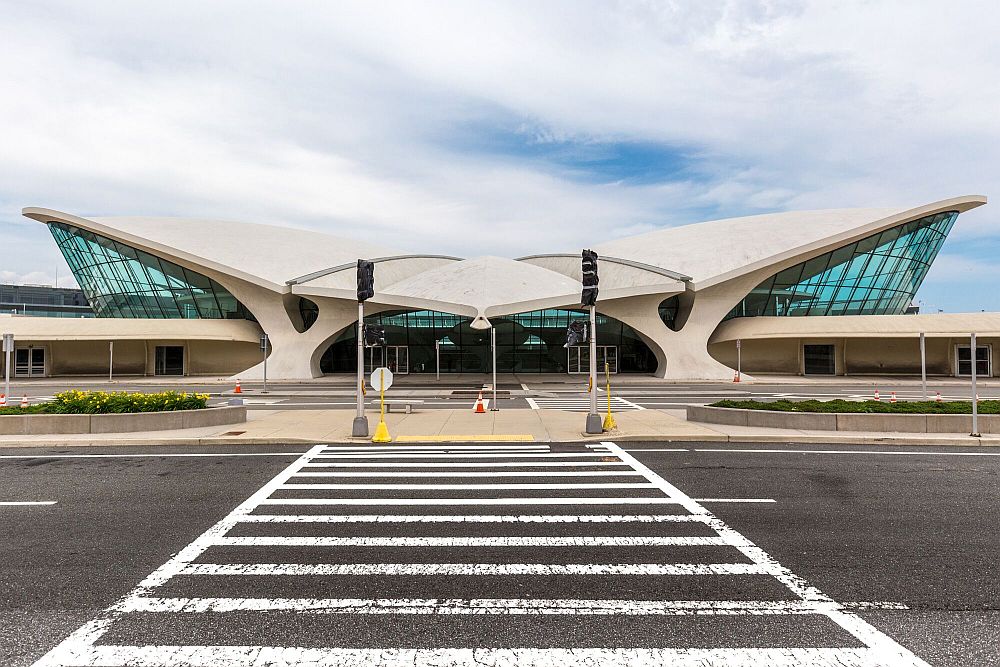
Disclosure: This TWA Hotel review contains affiliate links. That means I’ll receive a small commission on any purchase you make through these links. This will not affect your price.
This is a completely independent review. I was not sponsored or paid in any way by the TWA Hotel.
TWA terminal by Eero Saarinen
Finnish architect Eero Saarinen designed this elegant JFK airport terminal for TWA. It opened in 1962, the year I was born, and closed in 2001 when TWA was taken over by American Airlines. It sat abandoned, but protected as a New York historic landmark, until MCR/MORSE Development spent $265 million converting it to a hotel, according to the Wall Street Journal. It’s only been operational since mid-May 2019.
TWA Hotel is the only hotel within the boundaries of JFK airport, and sits close to JetBlue’s Terminal 5, where the “Airtrain” connects it to the other terminals.
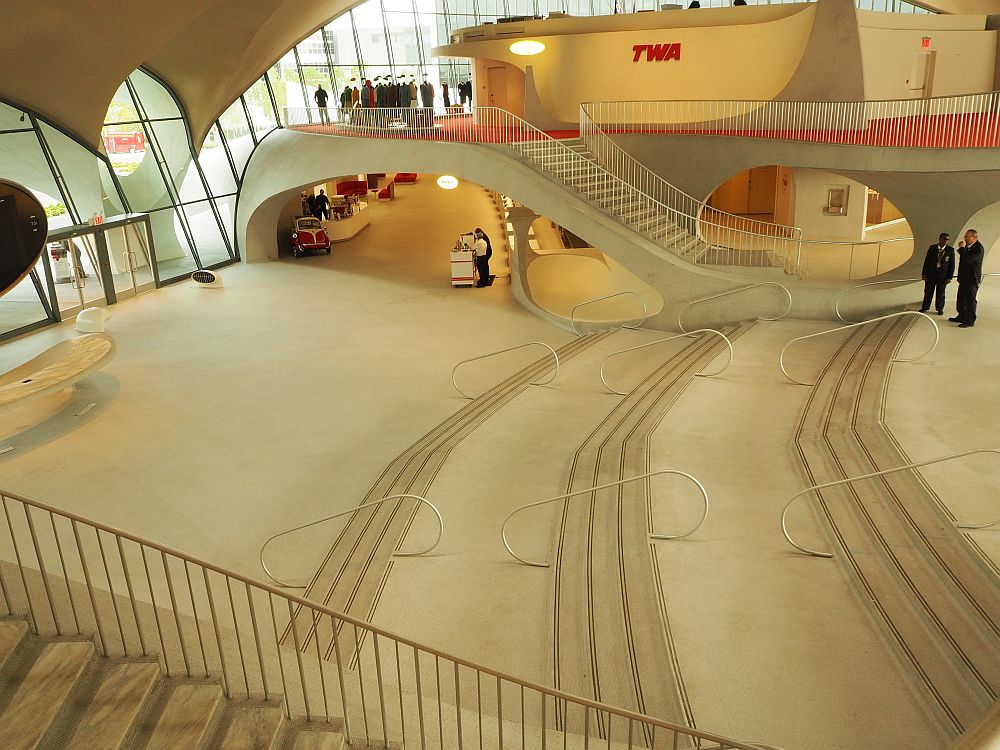
When we – my sister and I – stayed a night, it had only been open for a bit more than two weeks. I got the impression that it was mostly unoccupied, which made that soaring lobby all the more impressive. The operator’s aim is to reach more than 100% occupancy by renting rooms during the day as well as overnight.
Check it out on Tripadvisor.
TWA Flight Center
Now called the TWA Flight Center because it is no longer, strictly speaking, a terminal, the original hall has been beautifully restored and holds only the public areas of the hotel: reception, restaurants, lounge, and so on. The 512 rooms are in two newly-built additions, each a gently curving glass-sided building.

The “wow factor” of the original terminal is firmly anchored in the lobby. Entirely surfaced in the restored original white penny tiling, the view is all organic curves and huge windows.
To the left as you enter is “arrivals.” The former check-in counters, complete with a luggage conveyer belt behind them, are now reception counters. When I asked if the conveyer still worked, a hotel employee told me that yes, it still works, but bellhops had not yet been hired. In the future, once the hotel is established, luggage will be sent behind the scenes on the conveyer, where bellhops will pick bags up to deliver to the rooms.
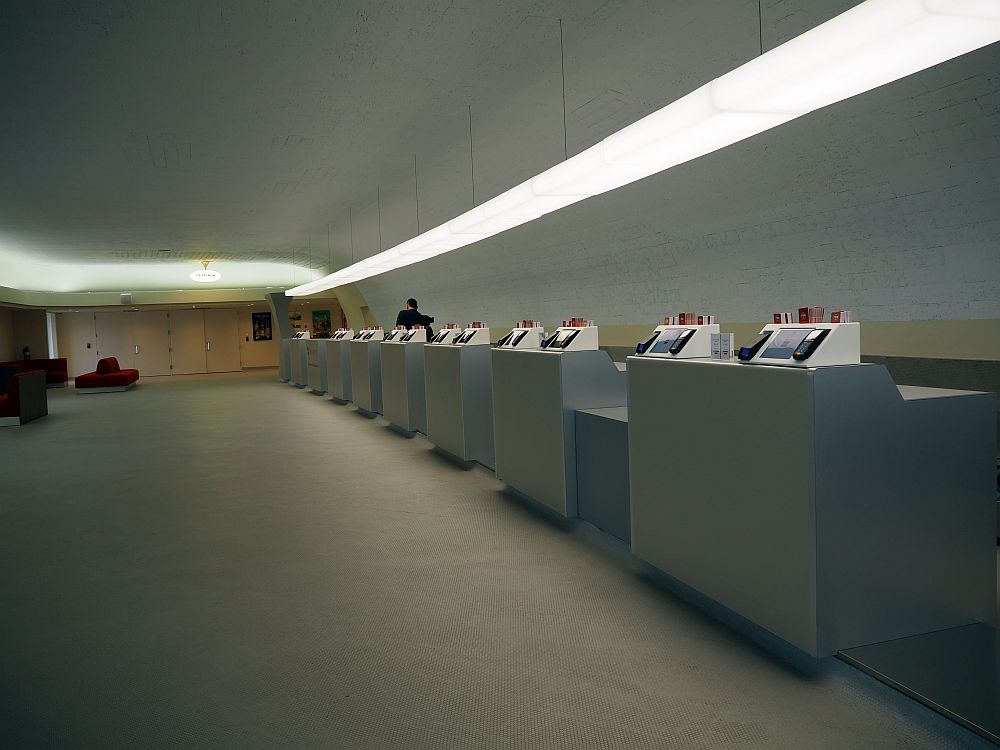
To the right, in “departures,” the check-in counters have been given over to food truck businesses, making it a food hall with affordable options, though not very many when I visited, since the counters have not all been rented yet. When I say “affordable,” by the way, I mean by New York City standards, where food, even from food trucks, tends to be pricey.
Straight ahead from the entrance, up a wide flight of steps, is the sunken lounge, originally a waiting area. The furniture here as well as in the whole renovated terminal fits the 1962 aesthetic, all simple curves and the TWA colors: red and white. A bar serves retro cocktails nearby.
Originally the wall of huge windows next to the sunken lounge would have looked directly out on the runway and TWA CEO Howard Hughes’s beloved “Connie” airplanes (Lockheed Constellations). These days Terminal 5 blocks the runway view. Nevertheless, a 1958 Connie is parked right outside, now serving as a cocktail bar.
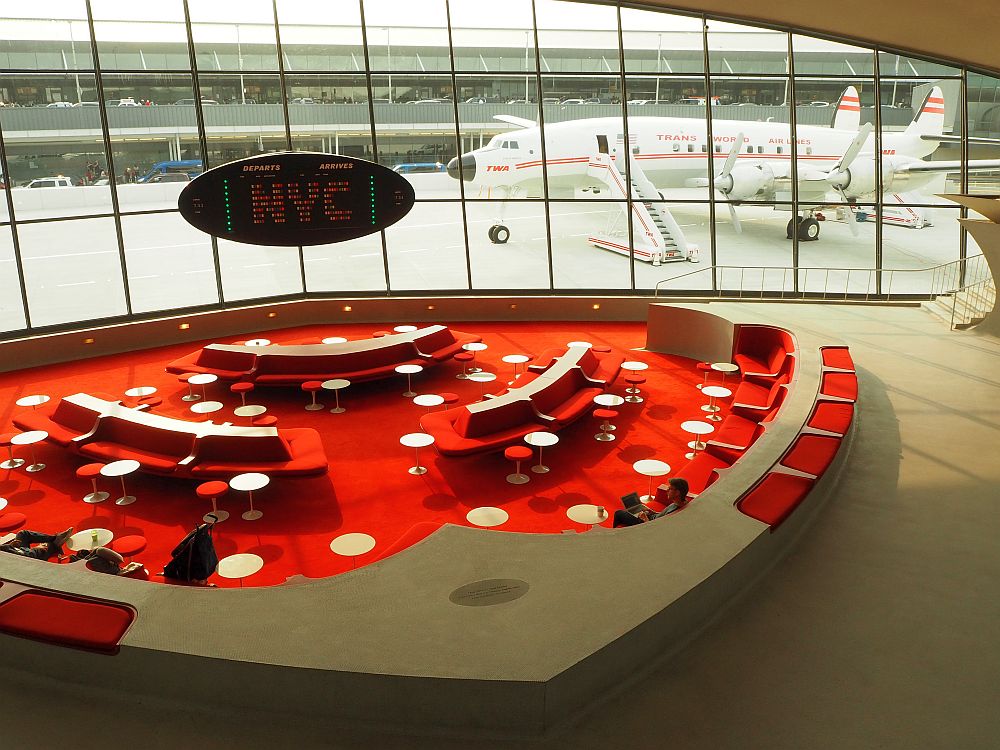
Upstairs on the mezzanine, the restaurant, called Paris Café, has the same name as and fills the same space as the original Paris Café in Saarinen’s TWA terminal. A timeline of vintage flight attendant uniforms by an array of top fashion designers is also on display on the mezzanine level.
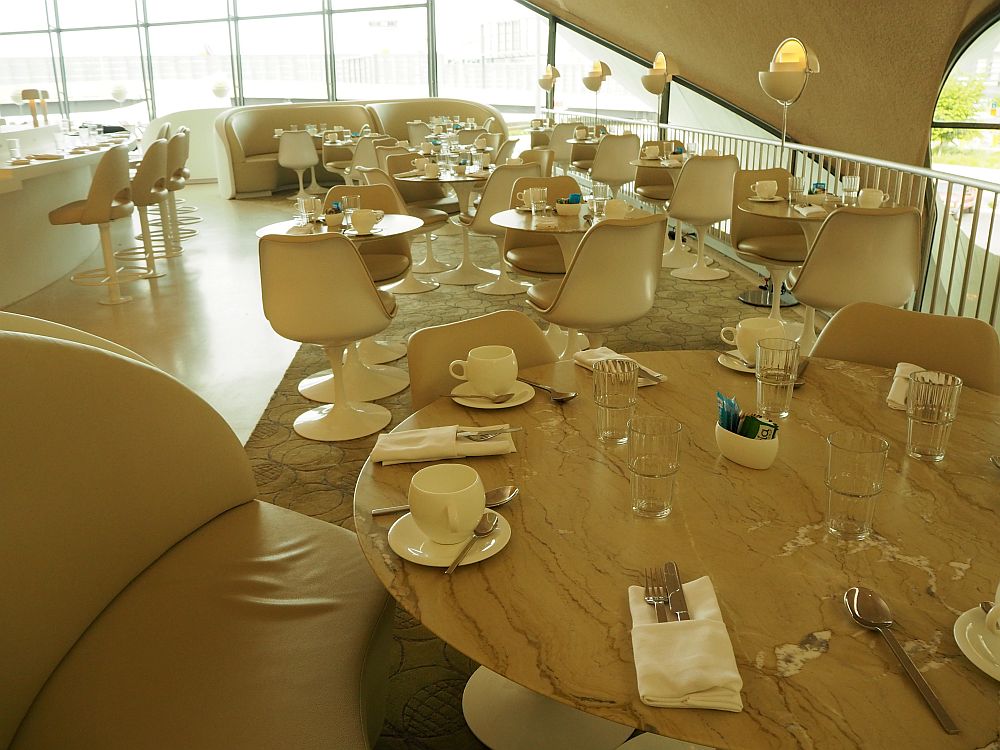
TWA Hotel review: the rooms
Getting to the rooms requires a fair amount of walking, some of which involves an uphill slant. The long, red-carpeted, tubular hallways leading to the “Saarinen wing” and the “Hughes wing” are decidedly space age, or rather a 1962 vision of space age. Originally departure/arrival corridors leading to the TWA gates, one now leads to JetBlue’s Terminal 5 while the other leads to a small museum.
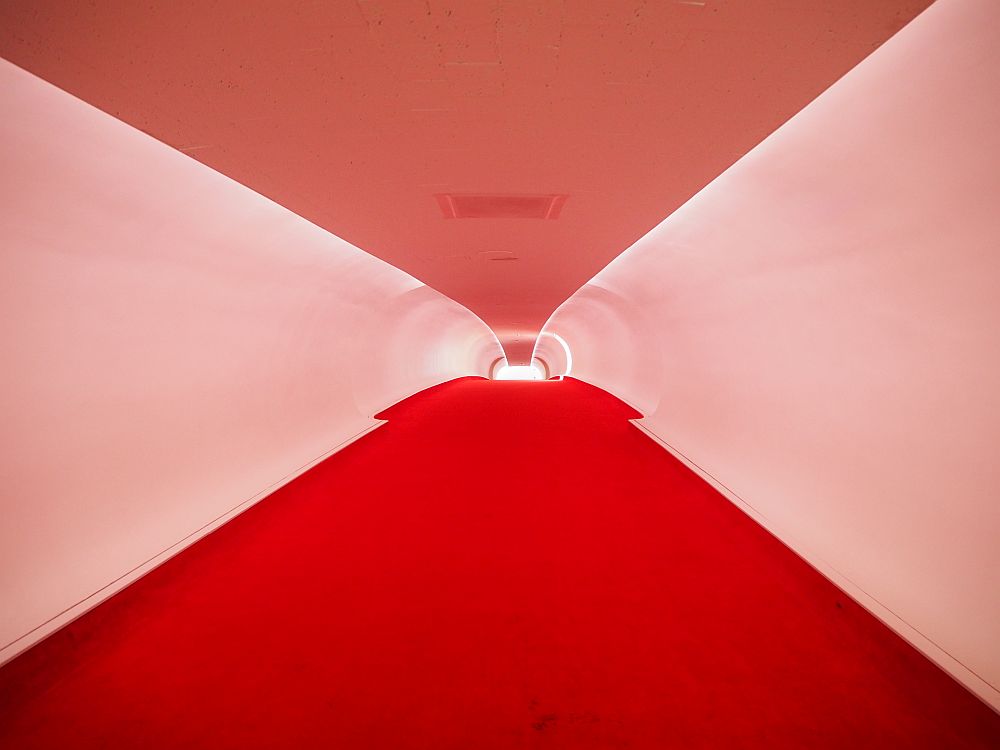
About halfway down each hallway is where the tube was cut on the side in order to connect each tube to one of the two new hotel blocks. From there, retro-style elevators – metal lined, with lighted floor numbers – take visitors to the rooms, which line long curved hallways. Again, this can add up to a lot of walking.
The rooms themselves are fairly unremarkable: upscale and chic, but not part of Eero Saarinen’s design. The brand’s colors and logo and the retro design furniture are the unifying factors.
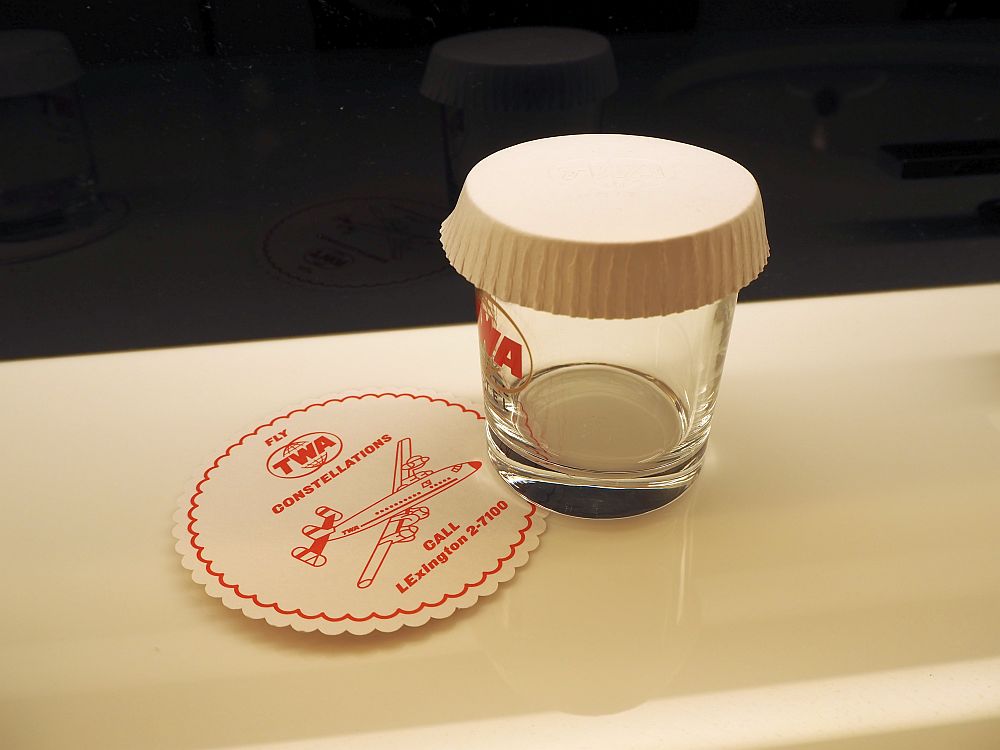
TWA Hotel’s rooftop pool
The TWA Hotel’s pool is on the roof of one of the new buildings: the Hughes wing. It took us a while to find it because signage is lacking. Of the three elevators in the Hughes wing, only two have a roof stop (marked just as R), and, of course, we got on the other one. Fortunately a random couple we asked in the hallway had managed to find their way there and could tell us the way.

The pool was worth the effort, though. It’s not big, and wouldn’t accommodate much real swimming, but it’s an infinity pool overlooking a runway, where we could watch airplanes take off quite nearby. Towels and lounge chairs are available, and apparently in the winter the pool will be heated to be used as a jacuzzi. The décor on the roof is all white, but the TWA-logo’d towels add bright red accents. There’s a bar and restaurant, too, though with so few guests when we stayed, it didn’t seem to be open.

It was warm enough when we visited to swim: or, rather, to soak while we leaned on the side watching the planes. The air has a tinge of jet fuel about it, but it wasn’t overwhelming and somehow added to the immersive airport feel.
Other features of the TWA Hotel
Fitness Center
In the basement is an outstandingly equipped fitness center; this is not something I use, but my sister was extremely impressed by the range of options it offers. TWA Hotel’s website says it is 10,000 square feet.
The Connie
The Lockheed Constellation parked outside serves as a cocktail lounge, and customers can also peer into the cockpit to see the complicated-looking controls the pilots and navigator used.
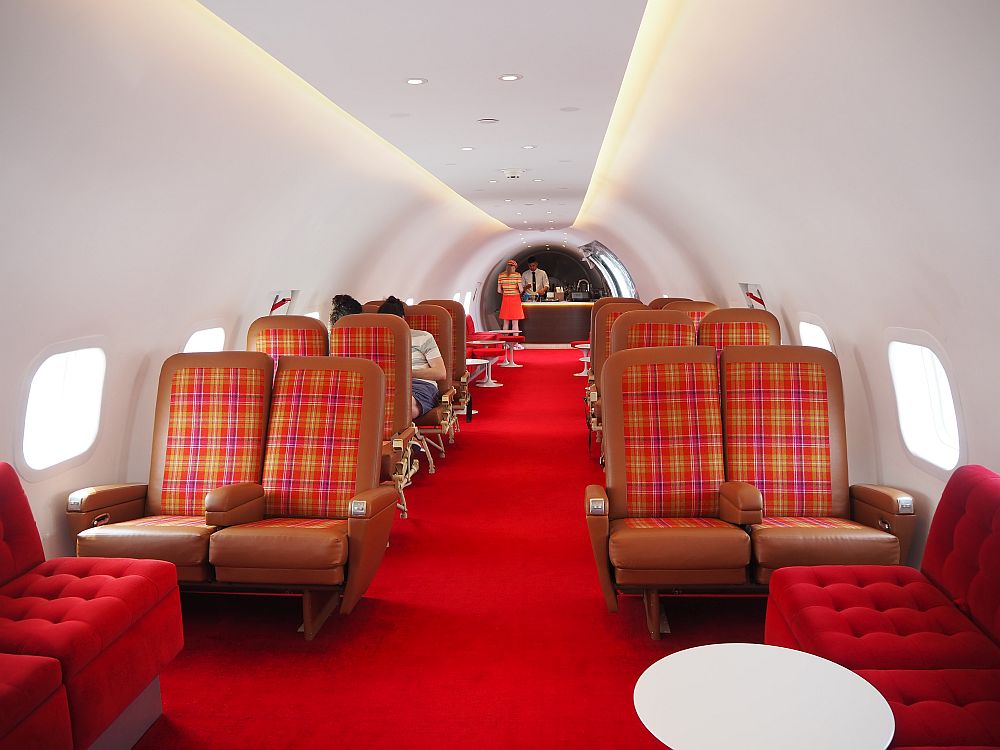
Museum
A small museum illustrates the history of TWA and commercial aviation history in general as well as the design of the building, showing items like in-flight amenities (such a contrast to today!), vintage furniture, uniforms, photographs and travel posters.
Shops
At the moment there are only three shops in the hotel. Shinola is a luxury watchmaker and also sells bags of various sorts. Warby Parker is a maker of eyewear but its shop is unmanned and contains no eyeglasses. Instead, you can buy – on an honor system – pencils with a variety of inscriptions or creative postcards. The TWA shop carries everything you can imagine with the TWA logo: shirts, caps, bags, shoes, umbrellas, and so on.
Reading room
Tucked in a corner, easy to miss, is a reading room, which is partly a place to sit and read in peace and quiet, and partly a book shop. The books – a very small selection – are all about design, but the real draw here is the Herman Miller design furniture.
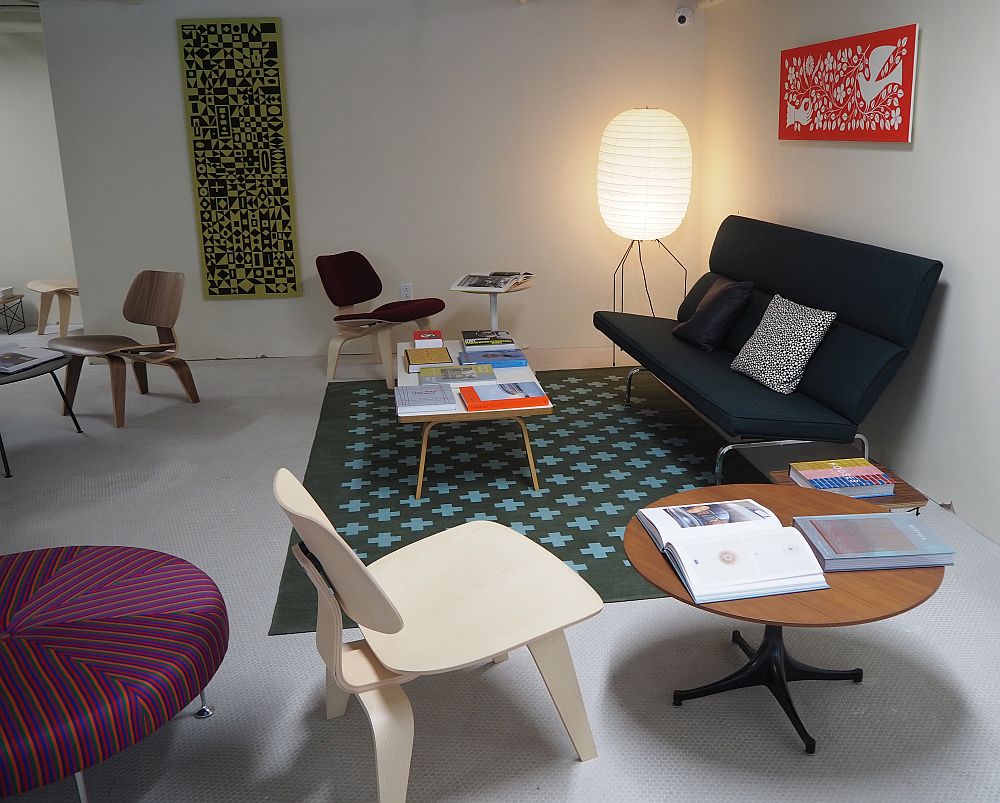
A Twister room
This feature was added after my stay: a room with a wall-to-wall Twister game for guests to play in.
TWA Hotel review: What I liked
The retro design of the TWA terminal
The nostalgia factor was high for me. It brought back memories, both of flying out of this terminal and of some of the retro styles: the furniture, especially in the reading room, as well as the flight attendant outfits. The small details are very well done, especially in terms of the retro touches even in the new buildings.
Two huge split-flap arrivals and departures boards emit that familiar click-clack as they update. The information is fictional, but the sound added to the retro atmosphere of the building.

The employees I spoke to seemed just as excited about the place as I was. They willingly answered questions about the company and the history of TWA and this terminal building at JFK.
In the morning a young woman dressed in a 1962 flight attendant’s uniform and a young man dressed as a pilot posed under the click-clacking departures board. They enthusiastically and knowledgeably answered all my questions.
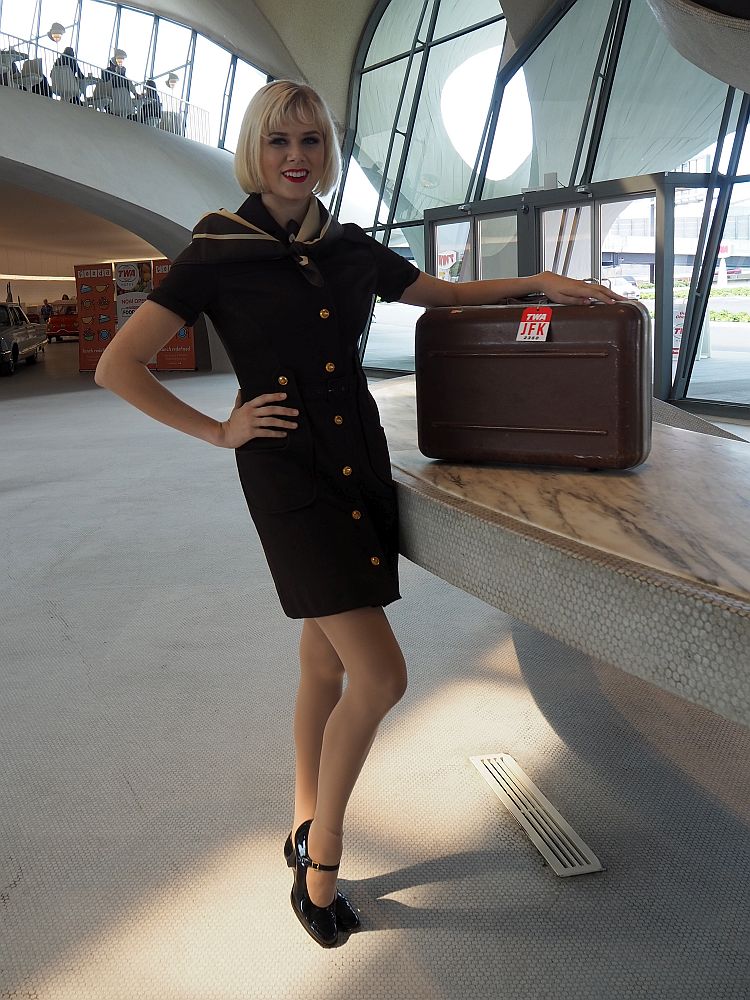
The pool
I could have spent hours at that pool, just watching the planes take off and land. Perhaps it’s my general fear of flying, but I have a fascination with planes.
The room
The room – a double queen – was very comfortable in every way: a perfect mattress, lots of soft pillows (no lumps!), and quality sheets. The blackout shades, electrically controlled, did their job well. The windows are soundproofed, so we didn’t hear any airplane noise at all.
The bathroom included pump bottles of shampoo, conditioner and shower gel, all TWA-labeled. The shower was excellent.
A well-stocked mini-bar, complete with cocktail and martini makings, mini-Etch-a-Sketch and model airplane, is very tempting and very expensive.
The design of the room incorporates retro elements to continue the theme from the original terminal. A pedestal side table and domed bedside lamp reminded me of similar pieces from my childhood. The rounded comfy chair is a Saarinen design. A rotary dial phone sits on the design desk. The bathroom mirror looks like a dressing room vanity with round bubble lights on either side.
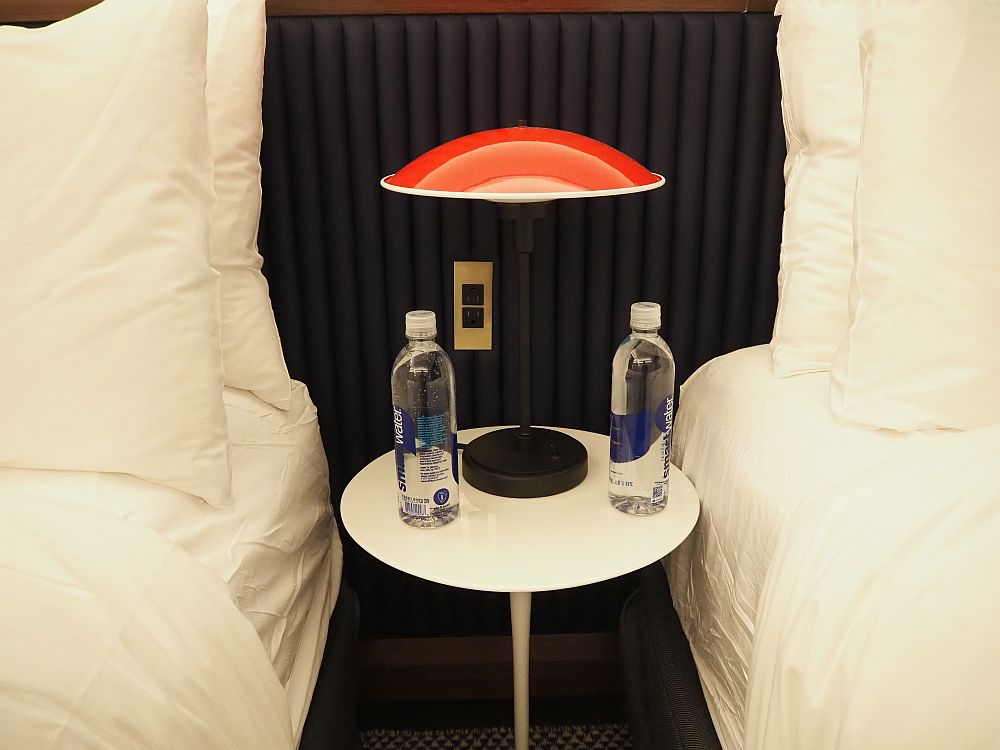
TWA Hotel review: What I didn’t like
In the hotel room
The TWA Hotel’s website is pretty light on photos and descriptions, and implies that the rooms all have either a runway view or a view of the Saarinen-designed terminal itself (for which guests pay extra). Our room on the 4th floor didn’t have either one. We looked out on Terminal 5 and could only see a few parked airplanes far over to the left.
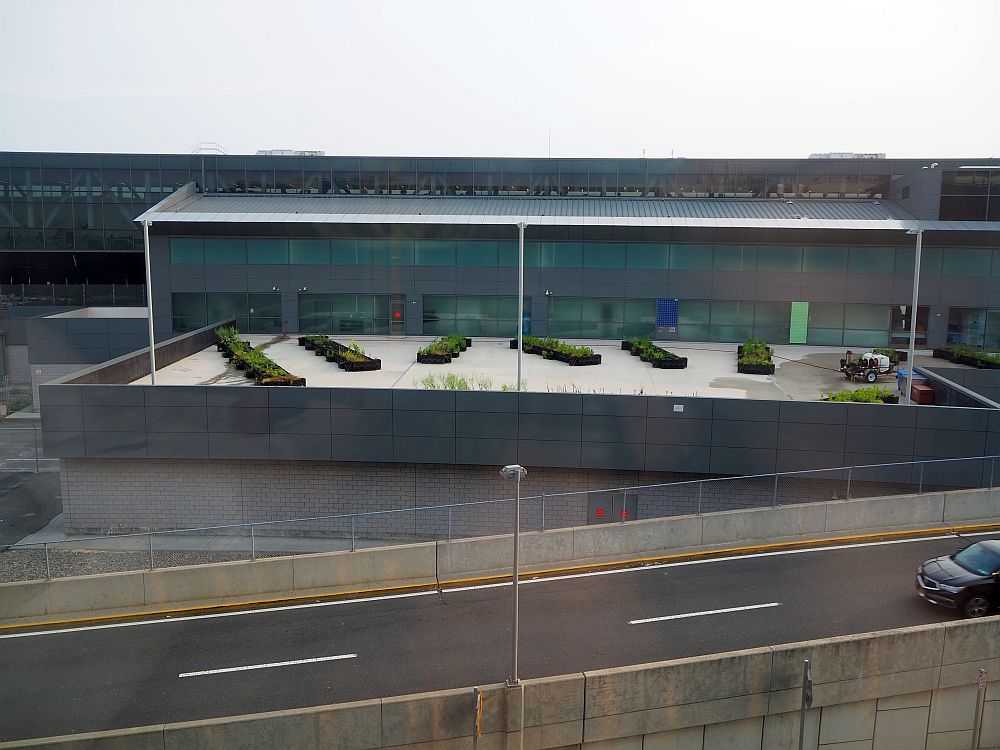
The website should be clearer about this. Apparently the rooms higher up do have a view over the top of Terminal 5 so they can see the runway. If the hotel operators are going to differentiate prices based on the view, these lower rooms should be cheaper than the ones with a runway view.
Also, those big floor-to-ceiling windows let in a lot of light, but face the terminal. That means people in the terminal – or outside it, walking to the Connie – can see right in. We noticed this when we walked out to the Connie and could clearly see a maid making a bed. Be careful of what you do with the shades up.
Instead of a list of mini-bar prices, a small sign gives a website address. I couldn’t be bothered to look it up. I was disappointed that, despite a very well-supplied mini-bar, no kettle or coffee or tea makings are provided in the rooms.
While I found ample electrical outlets, I was surprised, in a newly-built hotel room, not to find a single USB socket. Perhaps they’ve gone a bit too far on the retro. Yet a picture on their website shows a USB socket next to an electrical outlet, so perhaps they have USB sockets in some rooms.
If you’re considering a trip to New York, make sure to read these articles before you go!
Speaking of coffee…
Since there was no kettle in our room, my sister and I went in search of a cup of tea in the morning. There wasn’t any. The regular coffee bar, opposite the arrivals counters, wasn’t open yet, so a cart provided coffee … at $6 a cup. I suppose with a captive audience you can charge that kind of price.
We wanted tea, though, and they didn’t have that. Fortunately, my sister had a tea bag in her handbag and the people setting up the coffee bar were kind enough to give us cups of hot water so we could share the tea bag between us. I suspect this is just a newly-opened-hotel-glitch that will be straightened out as they get their systems up to speed.
Walking
I ended up walking a lot, dragging two rolling suitcases. Normally I don’t mind, but that red carpet inside that space-age tube is quite thick and slants uphill toward the elevators. When they have bellhops, this won’t be a problem anymore. Besides, I assume the carpet will get less thick with wear over time.
If walking is an issue for you, this hotel may not be your best choice. Most of it is wheelchair accessible, but if you’re walking, the distances are long.

Signage was rather poor, particularly on and near the elevators. Employees helped instead, but the company needs to make it easier to find the pool in particular, and to figure out how to get to the Connie outside.
The location of the TWA terminal
The renovated terminal is across the street from Terminal 5 and an Airtrain stop. However, a clear way to cross that street and access the Airtrain hasn’t been established yet. A fence blocks the Airtrain entrance from the street; I think it is assumed that no one would approach on foot. I ended up walking on roadways because there was no pedestrian access, and dragging two suitcases did not make this particularly safe.
I’ve realized since then that the problem was actually about signage and about how I was directed at the reception. After check-out, I could have gone back through the long tunnel to the elevator at its end (not the one that goes to the rooms) and taken that to Terminal 5, accessing the Airtrain that way. What puzzles me is why the person at reception didn’t point that out to me, instead vaguely directing me “just” to cross the street to get to the Airtrain.
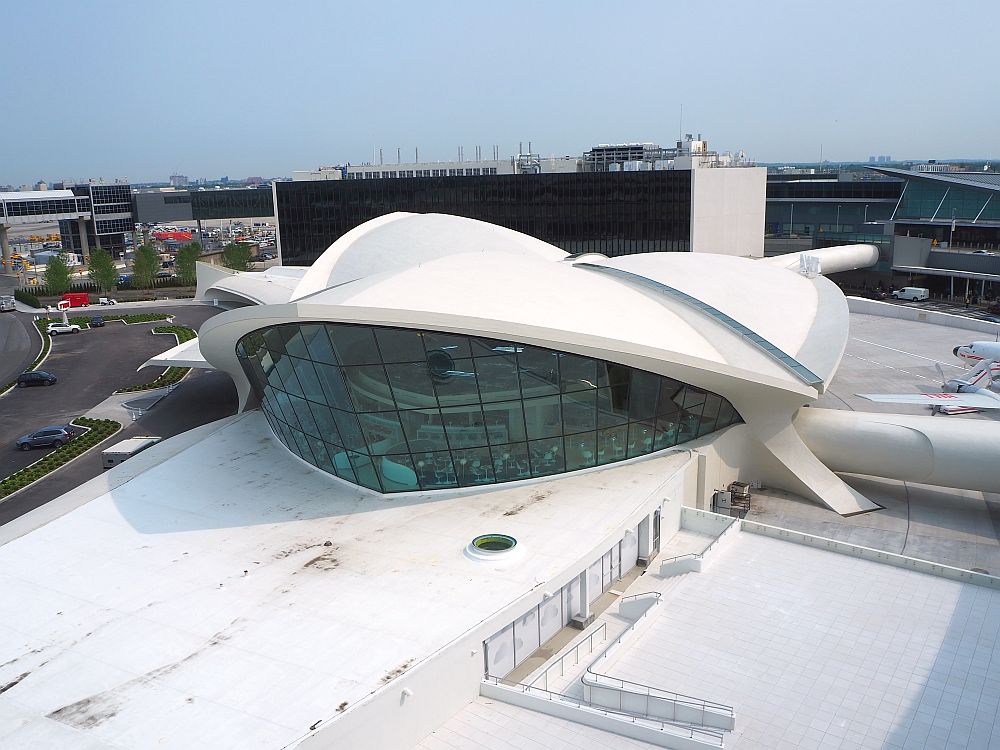
Since the TWA Hotel is in JFK airport, it is not a place to stay to enjoy New York City. It takes about 45 minutes by public transportation to get to downtown Manhattan via the Airtrain and then the subway system. By cab it should be about a half hour, unless you get caught in traffic, which is always a possibility.
Instead, stay at the TWA Hotel on your way in or out of town: when you have an early morning flight, stay here the night before. If you arrive late at night, stay here until morning. The hotel also offers day stays, so if you have a long stopover and need some sleep, this might be a good solution.
My TWA Hotel review and recommendations
For the quality of the hotel, the price per night is actually not too terrible (though it’s more than I’ve ever paid for a hotel room before); you’ll pay similarly for a four or five-star hotel in Manhattan. Our room cost $249 for the night, which turned into $300 with taxes and fees. For a good hotel in Manhattan, that’s a pretty standard price, as I discovered when I searched for a place to stay in midtown.
- Night stays start at $224 plus taxes and fees.
- Day stays start at $149 plus taxes and fees for 4 hours; $209 for 12 hours.
(Note added in November 2020: The prices are lower during the pandemic, starting at $127 for a night’s stay, $109 for a 4-hour day stay and $149 for a 12-hour day stay. Expect prices to go back up once people are flying again.)
So should you stay at the TWA Hotel?
Yes, if …
If you are an architecture geek, a retro 60’s geek, a design geek or an airline geek, the renovated TWA terminal at JFK airport is your dream come true. We felt it was worth the splurge just because … I’m a geek.
Maybe, if …
If you need a place near JFK airport, this is the nearest you can get, and the retro effect is a bonus. You might, however, be able to find something cheaper quite near the airport if the nostalgic atmosphere doesn’t interest you.
(Make sure to filter for “distance from John F. Kennedy Intl Airport” and check that they offer shuttle service!)
No, if …
If your purpose is to explore New York City, find a hotel in the city instead for about the same price.
A tip if you don’t stay there
If you decide you can’t or don’t want to stay at the TWA Hotel, that doesn’t mean you can’t visit it. The lobby, shops, and restaurants, as far as I could tell, are open to the public, as is the bar inside the Connie. You can always just go check out the public spaces in any case.
Would you spend the money to stay in the TWA Hotel? Add your comment below.
And please share this review far and wide on social media!
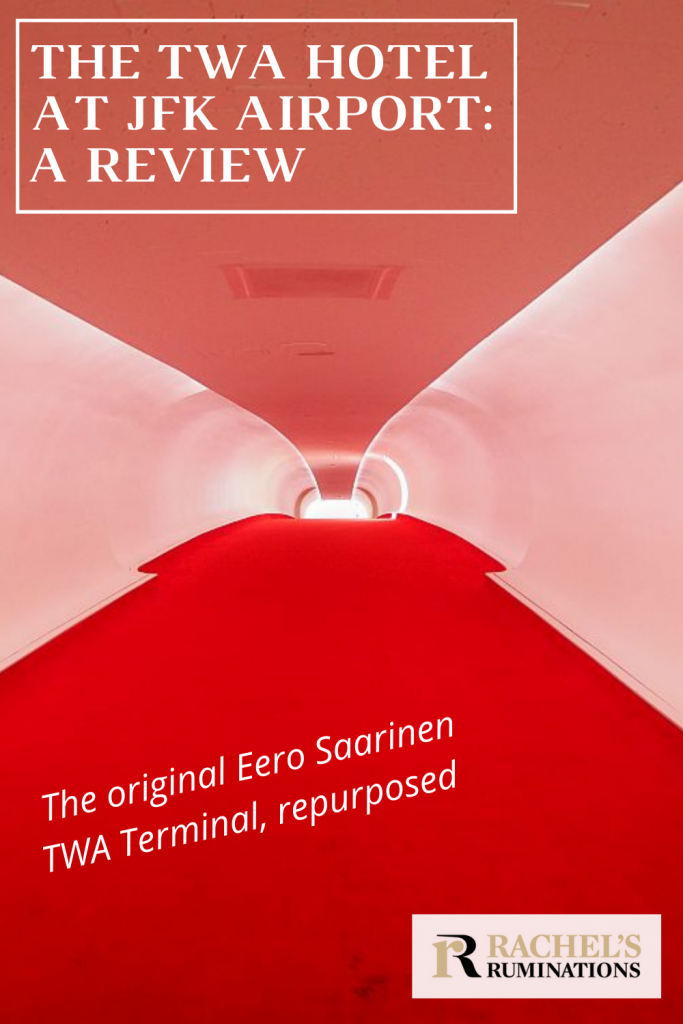


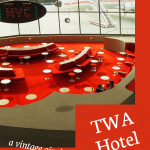
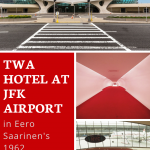
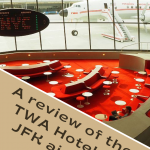


Coooool! I’d been wondering what the hotel ended up looking like and it looks fabulously cool. (Although I’m not sure about the long walk.) I love that they will be using the baggage carousel! We haven’t flown through JFK for quite awhile now, but next time we do, we’ll have to splurge on a room here when we have a long layover between connections. . . and maybe when it’s warm to use the pool! Great review.
I’d love to go back and use the pool when it’s jacuzzi-like! But I won’t spend that money again. It was a one-time splurge.
Great review! It seems a really novel idea and I like the sound of it, if I had a late arrival or early start.
I particularly like how you give us the real lowdown and divide it into a balanced yes,maybe, no.
A novel idea for an airport hotel – but looks so pricy! Does JFK have other airport hotels such as Novotel for example?
Thanks, Rebecca! No, it’s the only hotel within the grounds of the airport, but there are several nearby: in this price class, there’s a Marriott, a Hilton, a Radisson and a Crowne Plaza.
I was telling myself ..omg I need to stay here overnight…until you wrote the price! It’s because I like taking photos and plenty at the TWA is what they call instagrammable!
Please forgive me if this comment goes thru 2x as my connection was lost during transmission. What a unique place the TWA Hotel seems to be! Thx for introducing us to it. I’d love to stay there sometime … just for fun!
Go for it, it is fun! Don’t forget your bathing suit!
I’m very glad to hear the landmark architecture has been preserved, although it sounds from your review that the hotel still has some work to do. I remember passing through that terminal more than once in my youth and thinking it was beautiful…except for the long walks, which seem to persist. I’m going to check it out next time I pass through NYC, although as you suggest, as a tourist. Not much point in staying at JFK unless you’re transiting.
Good plan. And yes, I think much of it was just teething pains. They’d only opened 2 1/2 weeks before I stayed, and clearly aren’t quite up to speed yet.
What a terrific review! Everyone should read it before visiting the hotel. I’m glad I did!
Thanks, Irene!
Thanks for this in-depth review of the TWA Hotel. I’ve been curious about it. It is perfect as the only hotel within the boundaries of JFK airport. I’d love to have a drink in the Connie!
Hi Rachel,
Is there a way to date each blog post? Your text contains temporal references and without a blog date it’s hard to know if the issues and /or observations are worth researching (ie food truck observations). I can take a guess on when the blog was written via the date of the comments, but that might be an inadequate representation of when you visited. Any chance you might start publishing dates? Thanks, Beth
There is a way to date blog posts, but I choose not to do so because most of my posts are valid for a long period of time. I try to go back and update things like opening hours and prices from time to time. Having said this, I should have dated this one because, as you say, it was related to a particular moment. I posted it on June 8, 2019 and had visited about a week before that. The hotel had only been open about two weeks at that point; as I wrote in the article, some of the problems may have just been teething pains.